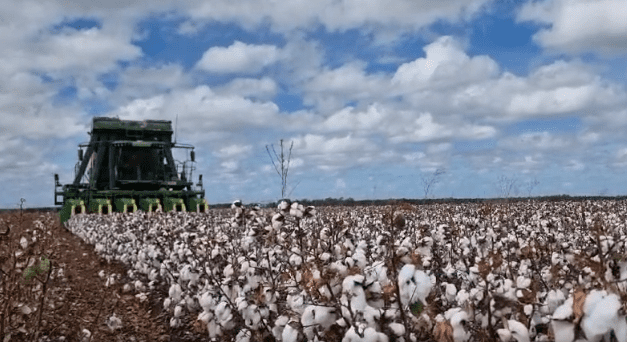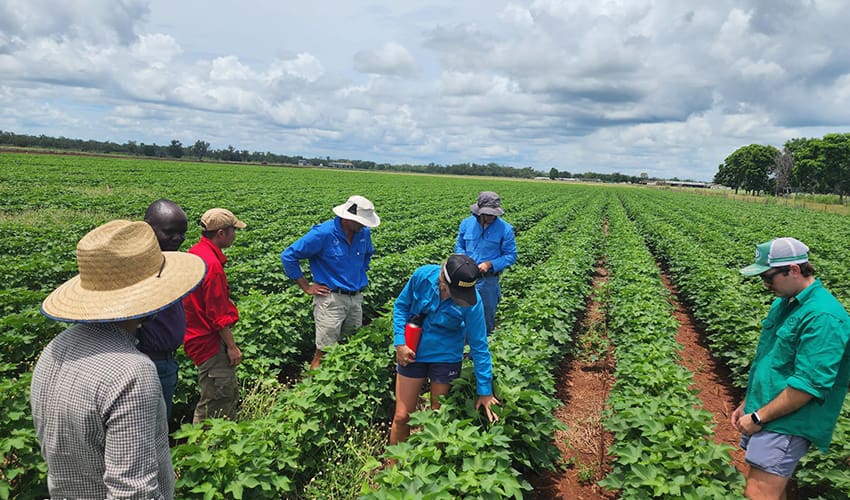
Picking at Cam Geddes’ farm near Emerald in CQ. Source: Cotton Australia, Renee Anderson
COTTON picking has commenced in small pockets across Central Queensland, while on the opposite side of the country, Ord Valley growers are nearing the end of a challenging planting window.
In total, Cotton Australia estimates close to 480,000 green hectares of cotton has been planted for the 2023-24 season, predominantly in New South Wales and southern Qld and New South Wales.
This is down from the 2022-23 area of 572,000ha.
CottonInfo regional extension officer based at Biloela Kim Stevens said approximately 26,000ha had been planted across CQ, including 1400ha of dryland crops.
She said plantings were down compared to last season due to a reduction in dryland area resulting from insufficient rainfall in winter and spring.
Ms Stevens said the crops struggled with humidity and hot weather during November which had impacted yields.
She said this had prompted most growers to extend their crops until winter.
“There were three fields in Biloela and three fields in Theodore that picked about three weeks ago and they were probably the first ones in CQ,” Ms Stevens said.
“In the last week, Emerald had one or two pickers kicking off but overall there is not going to be much picked at all until April, May and June.”
Ms Stevens said CQ growers were hoping yields would improve in coming months.
“It is not going to be a record season like last season…but you never know, if it remains dry and sunny, we might be surprised.
“At the moment, everyone is pretty happy to try and gain their yields back and focus on the next season.”
Picking is also under way at St George in south-west Qld, with those not picking yet expected to start in coming days.
Growers are reporting reduced hectares due to the rain coming too late.
Variation in north
At the other end of the season, Western Australia’s Ord Valley growers have a few weeks left in the planting window, which opened on February 1.
Cotton Australia senior policy manager – northern Australia Simone Cameron said Ord growers have had a tough few weeks.
“They are still planting and in the last week or so they have seen quite significant falls of rain from the low monsoonal trough,” Ms Cameron said.
“It has pulled our producers up from getting out on to paddocks.”
She said plantings across northern Australia are expected to be similar to last season at about 18,000ha.
“The intention was for a slight increase in planting for the Northern Territory, and North Qld and Kununurra were remaining as static.
“However, the Northern Territory has had a wet season that, like many, has been unique; so, therefore the opportunities to plant what was proposed originally didn’t necessarily get in the ground.”
Ms Cameron said NT growers, who plant from December 1 to January 27, had a “balancing act” between not enough moisture at the beginning of the season and too much at the end of the window.
“We had producers that managed to get the majority of their crop in during that earlier part of December (and) others that started and had to stop.
“We didn’t see any rain for a lot of December in certain areas, which meant there wasn’t enough soil moisture to plant the seed, and then in the first week of January the rain came.”
Of the earlier-planted crops, Ms Cameron said there was some fruit growth.
“[W]e are very much looking forward to when that monsoonal trough leaves and we can see a bit of sunlight; it will be really good in helping to set and mature that boll and fruit for picking later in the season.”
She said this season will be the first with an operational gin in the north, the opening of which has been a major milestone for the industry.
“The majority of the cotton will go through the Katherine gin and then we also have a gin that is being constructed in Kununurra that is on track for the 2025 season.”

The Katherine Research Station recently held a workshop for agronomists. Photo: Cotton Australia
Southern Qld progress
In the traditional cotton-growing areas, Cotton Australia reports most crops are progressing well towards picking in April.
On the Darling Downs, growers started defoliating last Tuesday, with picking expected early April.
Dryland crops are going well and another 50mm of rain will finish the crop off nicely.
South-west of the Downs, Dirranbandi has not fared well due to the lack of available water, while Mungindi is looking fantastic, particularly the dryland crops that have benfited from rain at the right time.
In the Macintyre Valley on the Qld-NSW border, growers are expecting average yields, with boll size down.
Growers have not started picking, and many are looking to the last water and defoliation, with picking expected to start in early to mid-April.
Patchy in NSW
In northern NSW, it’s a mixed result, with average to above-average crops expected, depending on the location, and picking to start around Easter.
Dryland crops would have benefited from earlier rain, while warm days and nights have helped irrigated crops finish the season well.
Gins are looking to start yo from mid to late April.
In the Macquarie Valley, results have been patchy, but growers remain hopeful of a reasonable season, with picking expected to begin in most regions in April.
While some have reported very healthy crops, cloudy days resulted in lost fruit.
On dryland, summer storms have provided some excellent conditions.
In southern NSW, growers are planning their last irrigation and are looking to start picking in late April; most of the picking is expected in the first week of May, and yield potential for irrigated crops ranges from average to slightly above.
Crop of 4.5Mb plus seen
Cotton Australia CEO Adam Kay said the area and production had seen a significant turnaround since earlier predictions.
“Our growers were expecting a long hot and dry summer forcing a crop revision below 4 million bales,” Mr Kay said.
“The rains across our largest growing areas were very welcome and now we are expecting at least 4.5 million bales, which will result in more than $3.6 billion for the Australian economy, much of which will flow back into rural and regional communities.”
Grain Central: Get our free news straight to your inbox – Click here

HAVE YOUR SAY